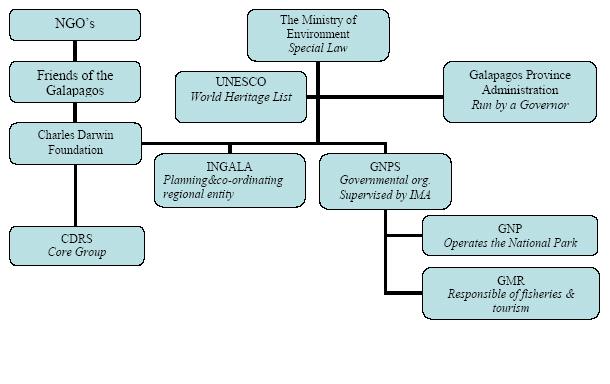In 1967, the Galapagos National Park Service was formed, and in 1978 UNESCO placed the Galapagos Islands on the World Heritage List. These actions brought significant international pressure towards taking care of this unique environment. The importance of preserving the ocean as well as the land led to the formation of the Galapagos Marine Reserve in 1986, and extended the protected sea area 15 nautical miles off the coast. The Law of Special Regime for the Conservation and Sustainable Development of the Province of Galapagos, established in 1998, planned the expansion of the Marine Reserve to cover 40 nautical miles from the coastline. It is now critical to ensure that there are adequate resources to guarantee effective implementation of these laws (World Heritage Committee [WHC], 1999).

There are five main authorities controlling and monitoring the Galapagos and surrounding waters (BOE, 2001):
1. Municipalities, local authorities and provincial councils facilitate and aid the local inhabitants on all islands.
2. The Navy patrols all waters surrounding the islands to enforce the policies about fishing and tourism.
3. Galapagos National Institute (INGALA) is constituted as the technical advisory body of the institutions in the islands. Furthermore, it is the planning and coordinating regional entity of the province of Galapagos, monitored by the President of Ecuador. (The National Congress, 1998).
4. The National Park Services controls 97% of the parklands and is under control of the Ministry of Environment, which is also responsible for tourism.
5. The Charles Darwin Research Station in Puerto Ayora provides knowledge and support to ensure the conservation of the environment and biodiversity of the Galapagos through scientific research and complementary actions.


